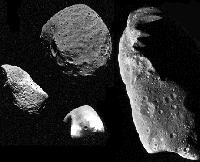 A slushy cocktail of water-ice and organic materials has been directly detected on the surface of an asteroid for the first time. The finding strengthens the theory that asteroids delivered the ingredients for Earth’s oceans and life, and could make astronomers rethink conventional models for how the Solar System evolved.
A slushy cocktail of water-ice and organic materials has been directly detected on the surface of an asteroid for the first time. The finding strengthens the theory that asteroids delivered the ingredients for Earth’s oceans and life, and could make astronomers rethink conventional models for how the Solar System evolved.
It has long been thought that asteroids, which lie in a belt between Mars and Jupiter, are rocky bodies that sit too close to the Sun to retain ice. By contrast, comets, which form further out beyond Neptune, are ice-rich bodies that develop distinctive tails of vaporized gas and dust when they approach the Sun. However, this distinction was blurred in 2006 by the discovery of small objects with comet-like tails in the asteroid belt1, says astronomer Andrew Rivkin of the Johns Hopkins University Applied Physics Laboratory in Laurel, Maryland.To investigate the composition of these ‘main-belt comets’, Rivkin and his colleague Joshua Emery, of the University of Tennessee in Knoxville, turned the infra-red telescope at Mauna Kea, Hawaii, onto the asteroid 24 Themis — the parent body from which two of the smaller comet-like asteroids observed in 2006 were chipped. Emery and Rivkin took seven measurements of 24 Themis over a period of six years, each time looking at a different face of the asteroid as it travelled around its orbit. They consistently found a band in the absorption spectrum of light reflected from its surface that indicated the presence of grains coated in water ice, as well as the signature of carbon-to-hydrogen chemical bonds — as found in organic materials. Rivkin and Emery’s work is published in this week’s Nature2.
“Astronomers have looked at dozens of asteroids with this technique, but this is the first time we’ve seen ice on the surface and organics,” says Rivkin. The result was independently confirmed by a team led by Humberto Campins at the University of Central Florida in Orlando. He and his colleagues observed 24 Themis for 7 hours one night, as it almost fully rotated on its axis. “Between us, we have seen the asteroid from almost every angle and we see global coverage,” says Campins. He and his team also publish their findings in this week’s Nature3.
Julie Castillo-Rogez, an astrophysicist at NASA’s Jet Propulsion Laboratory in Pasadena, California, describes the findings as “huge”. “This answers the long-term question of whether there is free water in the asteroid belt,” she says.
Icy interloper
Because 24 Themis lies only about 479 million kilometres from the Sun (roughly three times the mean distance from Earth to the Sun), it is surprising that the surface ice has not all been vaporized. Both teams speculate that more ice may be held in a reservoir beneath the asteroid’s surface, shielded from the Sun, and that this ice is slowly churned up as the asteroid is struck by small bodies in the belt, thus replenishing the surface ice.The findings lend weight to the idea that asteroids and comets are the source of Earth’s water and organic material. Geochemists think that the early Earth went through a molten phase when any organic molecules would have dissociated, so new organic material would have had to be delivered to the planet at a later time, says Campins. “I believe our findings are linked to the origin of life on Earth,” he says.To assess the plausibility of this scenario, astronomers must determine whether the make-up of 24 Themis is typical of other asteroids and, if so, what exactly they hold, says Castillo-Rogez. A priority should be to search for water ice on near-Earth asteroids that could be targeted by NASA’s planned robotic and manned missions. “If we find ice samples that contain the same ratio of deuterium [‘heavy hydrogen’ made up of one neutron and one proton] to hydrogen as seen on Earth, that would be a strong pointer,” she says.
However, 24 Themis may not be a typical member of the belt it could be an interloper that formed beyond Neptune, along with the comets, which was later knocked inwards, says Rivkin. If so, this would fit well with the controversial ‘Nice model’ of the evolution of the Solar System. Proposed in 2005, this model suggests that the giant planets Jupiter, Saturn, Uranus and Neptune and asteroids migrated to their present orbits after formation4. Either way, says Rivkin, “The old-fashioned picture of the Solar System in which asteroids are asteroids and comets are comets is getting harder to sustain.”(nature)




